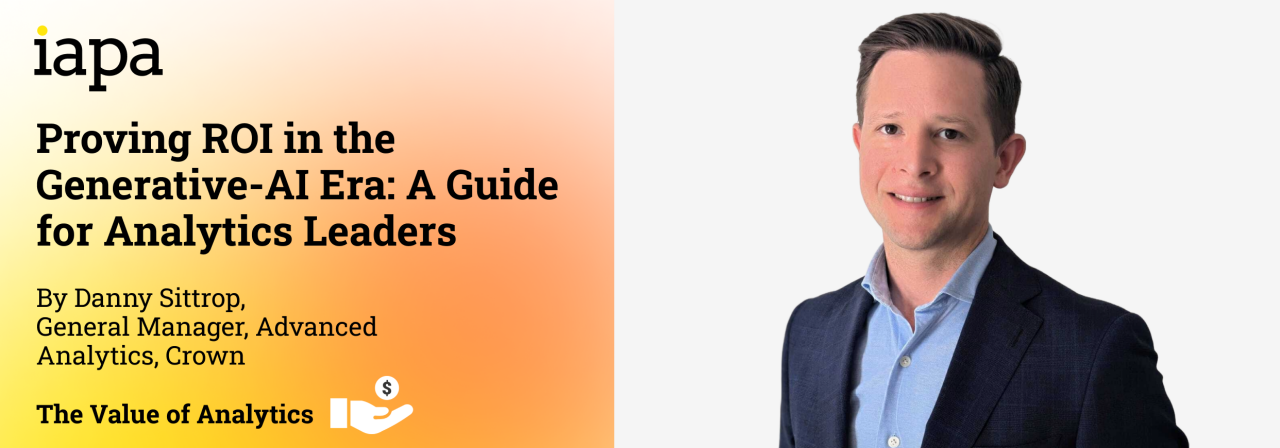
Proving ROI in the Generative-AI Era: A Guide for Analytics Leaders
By Danny Sittrop, General Manager, Advanced Analytics, Crown
Artificial intelligence and analytics is no longer a distant aspiration - it is a practical force reshaping every corner of business. Gartner recently counted 196 enterprise-grade conversational-AI platforms alone; factor in agents, optimisation, and predictive-analytics tools across every domain, and we are talking about thousands of solutions jostling for executive attention and market share.
Yet abundance creates its own trap. Leaders must decide whether to jump first and claim “early-adopter” advantage or to move as a disciplined fast-follower once technology has matured and risk has receded. Many organisations spin through an endless carousel of Analytics/AI proofs-of-concept (PoC) that never embed into standard ways of working or win sustained user support.
If AI and analytics value propositions seem obvious on paper, why do the benefits so often fail to materialise? Change-management research reminds us that roughly seven in ten transformation projects fail. In a world where the cadence of change is only accelerating, analytics professionals need the skills that reliably convert promising use cases into sustained business impact.
In the article that follows, I unpack how the analytics professional can orchestrate sustainable, incremental wins across the data value chain and translate them into competitive advantages for the wider enterprise. We investigate picking the right problems, mobilising people through change and creating a robust delivery runway.
1. Use cases that matter - introducing the ‘reverse-brief’
Great analytics and AI initiatives start with great questions, not great models. Enter the reverse brief.
A reverse brief as the name suggests is the brief back to the business in response to a business requirement. It is a one-page template that turns a fuzzy business problem into a shared, testable plan. It forces the analytics team to partner with the business, surface key questions, and confront assumptions and risks upfront. In other words, it’s the antidote to “promising” use-cases that descend into confusion and erosion of credibility - the place where PoCs so often go to die.
A reverse brief restates the business problem in analytics language, clarifying the hypothesis, underlying assumptions, and decision criteria. It then maps the desired business outcomes to measurable KPIs. In practice some details may be undefined at the outset. However, it is enough to guide portfolio-level prioritisation.
Just as crucial, the reverse-brief process reminds us that not every business problem should be solved with AI. Teams often jump to a preferred technology or solution before the problem and its benefits are fully understood. It gives a healthy nod to Occam’s razor, which favours the simplest effective approach.
The result? Effective prioritisation, shorter and more effective PoC loops, and clear requirements for each stage of the data value chain.
Tips:
- Keep it to one page. Long documents hide the signal; concise briefs invite rapid feedback.
- Challenge the hypothesis - politely. Ask “what would we do if the result is X?”
- Attach a straw-man metric. Suggest the uplift target or cost saving; it forces clarity on value.
- Log assumptions as test cases. Many “failed” projects actually succeed by disproving a shaky assumption; celebrate that learning.
2. Designing for change, not just the model
Data-and-analytics maturity rests on four interlocking pillars - data, technology, people and process.
That alone tells us sustainable analytical products demand more than a dataset, some clever code and a business problem to solve; they also require the right skills, capabilities and ways of working. Borrowing from John Kotter’s proven eight-step change-management model, we can build on his playbook that keeps all four pillars in view:
- Establish a sense of urgency. Where is the burning bridge?
- Form a powerful guiding coalition. Assemble a cross-functional team that blends technical depth, domain experience and organisational clout.
- Craft a clear vision. Articulate the future state in language the business - and the data team - can rally around.
- Communicate the vision widely. Use every channel, from town-halls to dashboards, to keep the story alive.
- Empower people to act. Remove blockers, provide training and give teams the autonomy to experiment.
- Generate short-term wins. Design PoCs to deliver visible value fast, proving the concept and creating momentum.
- Consolidate and expand. Roll early lessons into the next sprint, scaling what works and retiring what doesn’t.
- Institutionalise new ways of working. Embed the data products - and the behaviours that support them - into standard processes, incentives and culture.
The reverse brief introduced earlier underpins several of these steps: it crystallises the vision (step 3), guides communication (step 4) and sets the criteria for short-term wins (step 6). Meanwhile, the guiding coalition’s mix of business strategists, data engineers, analysts and change champions ensures every pillar - people, process, technology and data - is addressed from day one.
Execute this cycle consistently and you move beyond isolated proofs-of-concept, attracting the project’s own early adopters and early majority. The majority tipping point is what ultimately unlocks value at scale.
3. Data-value-chain-excellence
Don’t skip the “boring” links. Shiny models fail if ingestion, quality and governance aren’t rock-solid.
Have you ever seen a talented, ultra motivated data guru build the ML/AI model with train-test data only to be blocked when it comes to promoting and scaling the product into production? Often, this is driven by one of the following value chain elements not being considered adequately:
- Ingestion pipelines: Get the data when/where you need it
- Quality & Observability: Build data credibility
- Governance & Security: Thoughtfully decide on how to deal with data
- Feature engineering: Reinforce reusable assets for model builds
- MLOps: Seamlessly and quickly merge to production
- Decisioning/activation: Get the data to the applications that need it
With a much lower technical threshold required for teams to experiment with advanced analytics and AI, we need better capabilities which assists in the overall orchestration of the solution. Enterprise and data architecture provide the industrial-grade runway to ship and scale the solution. Enterprise Architects keep the why and the guardrails in focus - they make sure every ingestion, governance or MLOps choice, and intersystem integration supports the objective and overall strategy. Data Architects own the how of data excellence - from models to quality and security, they are the linchpin of reliable pipelines. Investing in architecture capabilities ensures that analytics professionals thrive, increasing the probability that analytics products successfully move from PoC to being fully integrated solutions.
Conclusion
Clear and sustainable ROI hinges on disciplined practices. First comes problem framing: the one-page reverse brief forces everyone to agree on the business question, the value and the success metrics up front. Next is mobilising people: managing change by combining domain experience, data talent and people leadership - turns early wins into the narrative that carries the wider organisation along. Finally, execution lives or dies on the strength of the delivery runway: ingestion, quality, governance, feature engineering, MLOps and decisioning must operate as one continuous product, steered by enterprise and data architects who align every technical choice with strategy. The opportunity for the analytics professional is clear: apply the reverse brief to the very next idea, enlist the right coalition and fortify the data value chain - then watch AI projects deliver the impact the business has been promised for years.
Download the one-page reverse-brief template, use it on your next analytics idea, and tell us how it went in the comments. What worked, what surprised you, and where did the value show up? Tag a colleague who should see the template and share your own tweaks so the IAPA community can keep refining the approach together.
